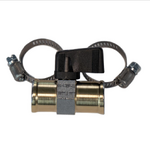Yes, you should also have removable radiator covers as well. Typically, you'll run without them on the trail and set up snow and with them on in deep powder. Hard plastic ones work and can be stored pretty easy since they are only radiator sized. Some prefer the cover to slide between the radiator guard (or stock plastic lovers) and the radiator. They secure well there.
I ran them that way on my first snowbike and it worked fairly good, but found that snow and ice would build up on the radiator guard and then when I needed the cooling and removed the covers, the ice buildup on the radiator guards hampered airflow to the radiator. So I started using radiator covers that sat outside (in front) of the radiator guard. You can do this with hard plastic or flexible material. I found a flexible material and did a sort of one piece bib on the next snowbike. It worked great as it covered the entire front of the bike left to right, shroud to shroud. If I wanted a bit of exposure/flow, I would fold down the top edge on one or both sides of the bib and expose the upper portion of the radiators but still keep them mostly still protected from snow blast. This bib prevented all ice build up and was very effective at blocking cold air and snow. That bib, along with a retail engine blanket and homemade rear engine blanket made from the same bib material, proved to work great and engine temps stayed up.
The next build, and my latest, is similarly protected and complete in coverage, but this build I started with Selkirk engine cover. I used 1/4 thick, closed cell foam sheet to go under engine between engine and skid plate touching the engine (this is a yamaha so selkirk heat exchanger is up front rather than below engine like for other bike brands). Ran the same foam from under the engine up behind the engine to block and insulate from the rear plus a yeti enclosed tunnel throws less snow. On previous kits, in addition to blanket on the rear of the engine, I blocked the top front of the tunnel to stop snow from being thrown up.
The Selkirk has a removable radiator shield panel, but they are screened towards the top so I used the same flexible material as my previous bib to create a shroud-to-shroud bib that is held in place by the removable Selkirk radiator partial covers. This bib lays all the way up the front of the radiators and back across the top of the radiators. Great coverage and I have 3 levels of coverage to choose from: Run with all of it in place, remove only the bib or also remove the Selkirk radiator panel to get a lot of airflow and exposure. Works great. I run 170 F. to 190 F. most deep powder days. I have a 194 F. (90 C.) C3 thermostat which starts to open around 188 - 190 F. I'll only hit above 194 F. on low speed trail work or long steep uphill pulls. With radiators uncovered and on the trail, if temps creep up over 200 F., I speed up. Anything over about 20 mph will bring my temps back down and keep them there.
For me, the key has been wrapping, blocking, covering as much as possible. Then, other than covering or uncovering the radiators for the day's conditions, the thermostat and radiators do their job without much drama. Would be even better with tunnel cooler replacing one of the radiators.



![20200101_142821[1].jpg 20200101_142821[1].jpg](https://www.snowest.com/forum/data/attachments/281/281648-be8dd9ed66505f99b1cf0ac1225f68fc.jpg)

